Signs giving orders with red circles are mostly prohibitive (i.e. they tell you what you can’t do). Often there are plates below the signs to convey a further message, such as whether it only applies between a certain time. Check out these common road signs giving order which are included in the Highway Code test that you will definitely see when you drive in the UK.
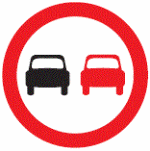 |
No overtaking. This sign could be in force for a number of reasons, such as the road has poor visibility, it is too narrow for safe overtaking, or there is a high likelihood of vehicles pulling out from parking spaces or driveways which would increase the risk of a head-on collision |
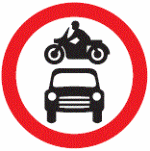 |
No motor vehicles. You must not drive any motor vehicles down this road. This might be an area reserved for pedestrians, for example. |
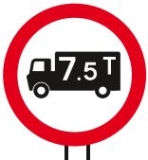 |
No goods vehicles over maximum gross weight shown. This may be because of weight and/or size issues. Many bridges are not structurally strong enough to support large vehicles, and some roads are quite narrow therefore excluding heavy vehicles from them reduces the risk of vehicles becoming wedged between buildings or being unable to turn on tight, narrow streets. It might also be used to prevent heavy vehicle drivers from using residential shortcuts. |
 |
No vehicle or combination of vehicles over length shown. This sign might indicate that there are corners that are too tight for long vehicles to negotiate, or there could be a risk of grounding. |
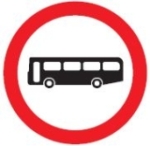 |
No buses (over 8 passenger seats). Like other signs for large vehicles this could be because buses would be unable to manoeuvre through the obstacles in the road. |
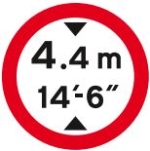 |
No vehicles over height shown. This sign is often shown to warn of low bridges or other obstructions that might be hit by vehicles that exceed the height (cables or other structures, for example). The sign shows the height in both metres and feet. |
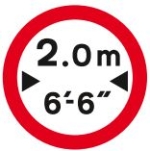 |
No vehicles over width shown. This sign might be shown because lanes are narrow, or local authorities want to restrict heavy goods vehicles from using the road. The sign shows the width in both metres and feet. |
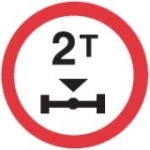 |
Axle weight limit of two tonnes. If your vehicle has four axles then you could theoretically drive it if it was up to eight tonnes, depending on the distribution. This sign indicates that there might be a weak structure such as an old bridge, which might not cope with excessive weight. |
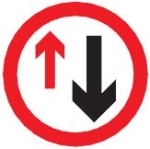 |
Give priority to vehicles from opposite direction. This sign will have an equivalent the other way with you getting a black arrow and the person travelling towards you a red arrow. The signs are usually positioned to give the effect that both vehicles have to slow down to consider the obstacle as this is ultimately the safest. |
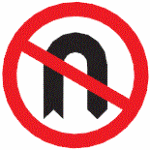 |
No U-turns. Doing a u-turn here might cause a danger to vehicles travelling in the other direction (e.g. they might be travelling quite fast and not be able to stop in time), or you might hold drivers up behind you which will increase the risk of a nose-to-tail accident or some other incident caused by frustrated drivers. |
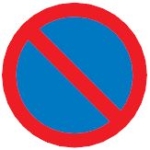 |
No waiting. Waiting might cause a danger to drivers because they may be forced to overtake in a dangerous position, or you might find this on busier arterial routes where the heavy volume of faster-moving traffic should not have to negotiate a stationary vehicle. |
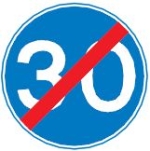 |
End of minimum speed. If there was a minimum prescribed speed limit (in this case 30 mph), you can now drive slower than that. |
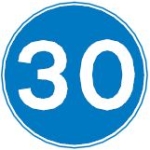 |
Minimum speed. You must keep your speed above 30 mph. |
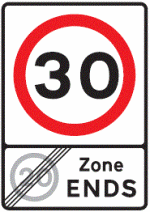 |
End of 20 mph zone. The strikethrough on the 20 mph sign means that it’s now a 30 mph limit, as indicated by the 30 in the red circle. |
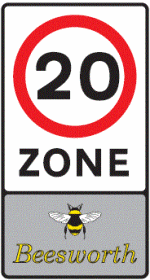 |
Entry to 20 mph zone. This shows a location of the sign, too. |
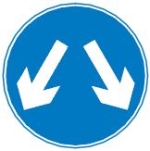 |
Vehicles may pass either side to reach same destination. These signs tend to be shown on traffic islands in the middle of two lanes of traffic travelling in the same direction. |
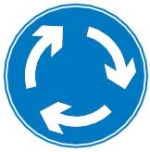 |
Mini-roundabout. Roundabout circulation – give way to vehicles from the immediate right and treat it like a roundabout rather than a junction. |
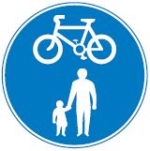 |
Cyclist and pedestrian route. This is a shared route. |
 |
With-flow pedal cycle lane – a bike lane that follows the same direction as traffic. |
 |
Contra-flow bus lane. This sign indicates there will be a bus lane on your right but with buses travelling in the opposite direction. |
